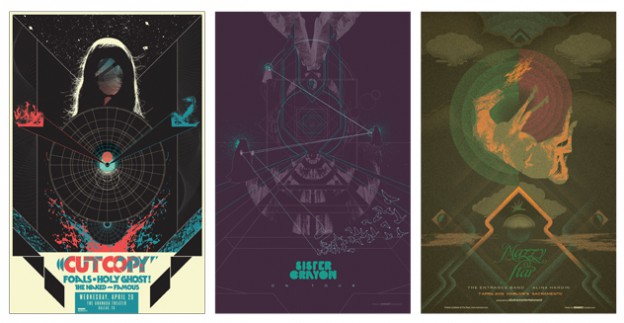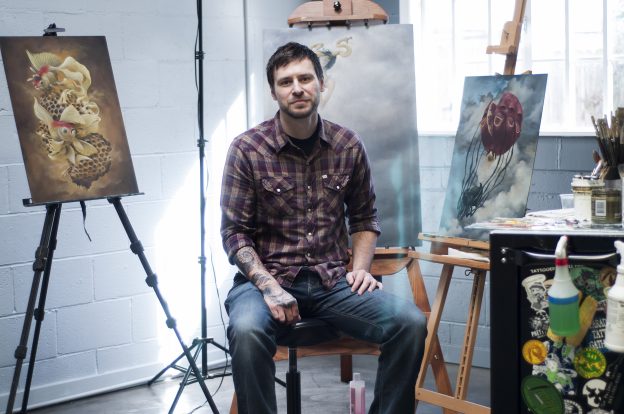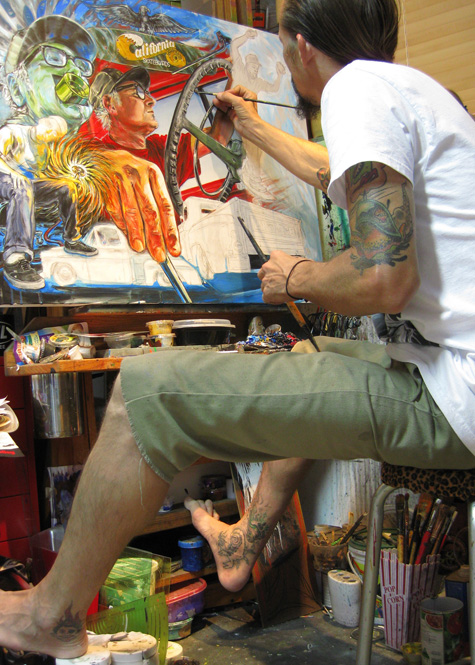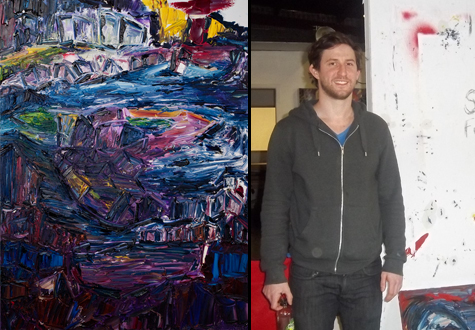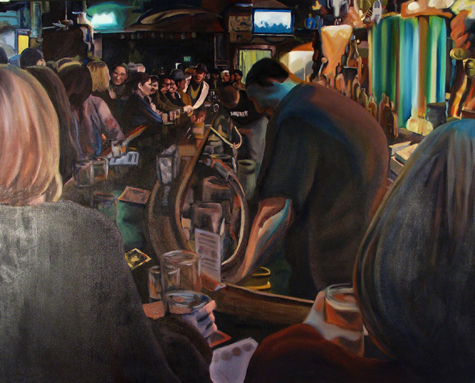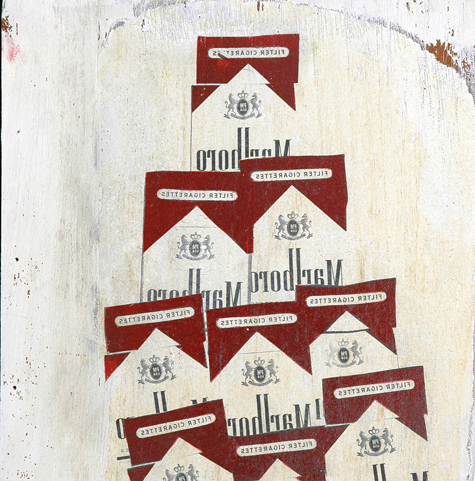How local graphic designer and poster artist Jason Malmberg came up through the ranks
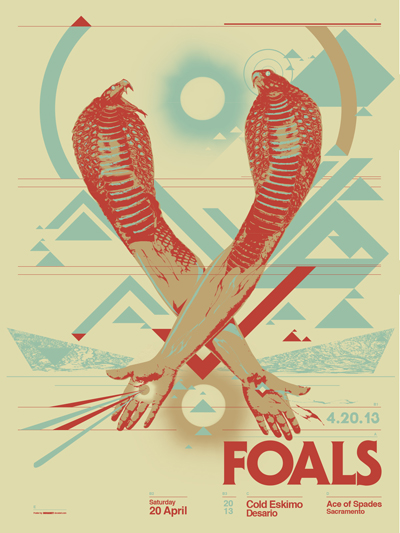
If you look at a Jason Malmberg poster and you’re unsure at first of what you’re looking at, if you need a minute to stare and process, if things seem off balance, if for a moment you feel like you are looking at a worksheet out of a German school book—don’t be alarmed. This is just the effect the local graphic designer is going for.
In the ‘70s, even public service announcement posters were psychedelic, Malmberg remembers, including one he’ll never forget. It was of a sobbing child throwing his arms over his head in horror, except his arms were 13 or 14 snakes. The poster read, “Why you shouldn’t take LSD” and went on to list what happens in the first 15 minutes, and in the second.
Take a look at the poster Malmberg made for the Foals show at Ace of Spades last month, and in the midst of colliding geometric shapes, you’ll see two intersecting male arms, each turning into the head of a snake from the elbow up.
Malmberg sampled two to four hands, arms and snakes to put together that image alone. “I don’t like hacking on other images,” he explains over the phone from his home office. “I want it to be more my own.”
So he salvages bits and pieces from historical images and online library archives public libraries, sometimes drawing on top of them, to recreate entirely new concepts, often with a ‘60s and ‘70s feel. Then he’ll lay out some type—and as a self-proclaimed typography nerd, this is key.
For the last 13 years, Malmberg has designed posters for just under 100 shows, including mainstream acts like Mos Def and the Violent Femmes as well as indie rock band Foals and former underground pop band Luna. Next month, he will showcase some of his pieces in his second-ever poster art show, Modern Lehzure, at Cuffs in Midtown.
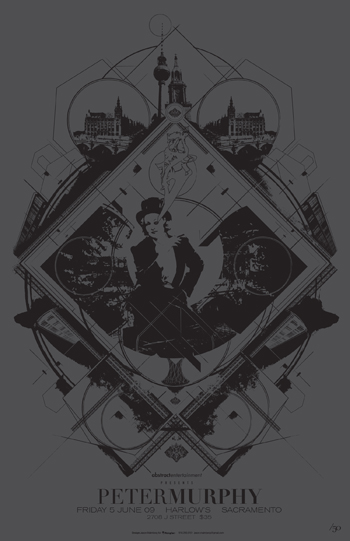
Visit Decabet.com and you will get a taste of Malmberg’s work. Yes, decabet, as in Dan Aykroyd’s 10-letter alphabet on Saturday Night Live.
Poster design is Malmberg’s ultimate outlet. What he hasn’t been able to get away with in his day job, he has gotten away with in poster art.
Within the last year Malmberg landed a job with a branding agency in Washington, D.C, where he is now developing his Web skills. Before that, he worked in print, as an art director for a handful of local publications, like Sacramento News & Review, Sactown Magazine and MGW.
While he was with Sactown Magazine, one of his designs popped up on T-shirts at Nordstrom sometime in 2007. You’d never know it, he says, and that’s probably all for the best. Unfortunately, his unique filigree design somehow became a part of the douche bag national uniform, he discloses.
Regardless, life wasn’t always peachy for Malmberg. If anyone has earned the seat they are sitting in now, he certainly has. It took a lengthy series of events to get him here.
To put it bluntly, “I’ve worked every shitty, low-paying job you could imagine,” he says.
This includes working fast food joints, at an eyeglass factory, in furniture assembly and smoothing down edges of windshields for eight hours a day.
Malmberg’s beginnings took place in Omaha, Neb. His teen years preceded Saddle Creek Records.
“It’s still not really cool to be from Omaha, but more than it was when I was there,” he says. “Now Omaha is sort of like a mini Athens kind of city—not Greek obviously—with their hipster cred. I was there in 1999, when it was a terrible wasteland and our claim to fame at the time, which everyone is still trying to live down, is 311.”
He studied under a “hands-off” kind of art teacher in the Omaha suburb of Bellevue, who provided Malmberg with just the right amount of guidance that made him successful. He had gallery shows before graduating from high school and went on to study at the Art Institute of Chicago.
Unfortunately, along with admittance into one of the best art schools in the country came unlimited pretentiousness.
He was surrounded by art students. To his dismay many of them were kids desperately attempting to fit social roles and convince the world they were someone other than themselves.
He quickly came to this realization: “I love people who make art, but I hate artists.”
He also realized that the Art Institute was not for him.
“I was making less art than when I was just a bum working at Taco Bell,” he remembers.
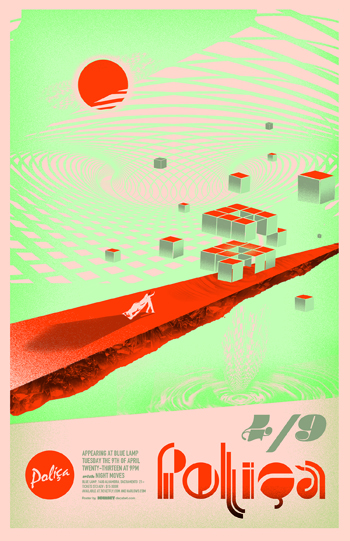
So, a year into it, Malmberg did what many students who find themselves in similar situations don’t have the courage to do—he left.
He returned to Omaha at 19 and began designing T-shirts for his friend’s skateboard gig. It seemed like a good idea at the time he said, but it didn’t last long. Then he took on the factory jobs. After that he spent three years as a rave promoter in Omaha. The last rave he threw was in 1997. It was going to be a huge party, outside. Tons of people were going to be there. This was the one that was going to lift him out of poverty, he thought.
Not quite. But it did result in him getting work laying out classified ads for a small local publication called The Reader. It started out as work to repay a debt. Up to that point he had never used a computer to design.
“I had no idea what I was doing,” he confesses.
The bus only ran twice daily between his place and the office, so rather than go home he would stay all night at the office and teach himself how to design. Eventually he was bumped up to art director.
Within about 18 months he redesigned the publication, drawing national accolades. Sacramento News & Review took notice and offered him a position as art director. He took it, and moved to Sacramento in 1999.
In 2006, he connected with the editors of Sactown Magazine when the publication was in its infancy. He became their art director, and helped create the look of the publication from its inception in 2006 until last year.
It was only a matter of time before he ran into local promoter and legend Brian McKenna in the early ‘00s. Next thing you know, Malmberg was designing posters for local shows on the side.
As his designs have improved he has become more selective about which shows he designs for. If he’s designing a poster for a show, it’s because he’s a fan of the band on the ticket. He doesn’t get paid much, if anything, for his work. He designed the Foals poster out-of-pocket. Hearing back from the band, however, is excellent compensation.
When Malmberg designed a poster for Luna’s show at Harlow’s in 2005, the band liked the design so much they asked to repurpose it as a limited edition sale item for their final show in New York. By the third show they sold out of 250 posters. The following year they used the design again for the DVD cover of their farewell tour.
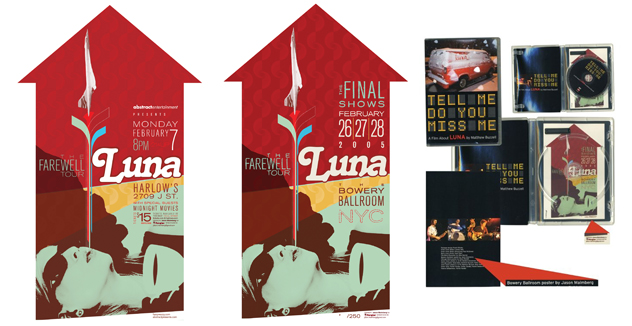
Regardless of who he designs for, he makes it a point to represent the band properly through his design. For each band poster he designs, he’ll listen to the albums to come up with a theme. Each poster should have its own feel.
“You don’t want to be one of those guys who’s basically just churning out art prints and tacking band names on them, because that’s not cool,” he says. “If the bands don’t sound the same, the posters shouldn’t look the same.
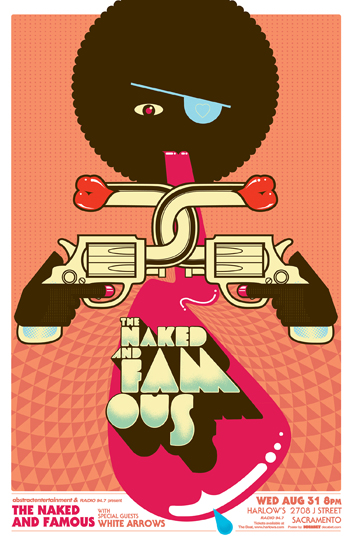
“I don’t try to be literal or narrative,” he says.
That’s how he ends up with posters that look like German ice cream bar wrappers from the ‘70s, like the one he made for the Naked and Famous show. Both fun and grotesque, what looks like a Reese’s Peanut Butter Cup wags its tongue beneath the noses of two interlinked revolvers.
Malmberg explains the look on his website.
“With the band’s bright candy-colored-yet-tasteful aesthetic in mind, I had the idea to try to make something a little European and a lot of odd,” he says. “I started out wanting to make something bizarre in the Polish movie poster vein but ended up with something a bit more like a German ice cream bar wrapper from the ‘70s. A little pop-art, a little glam, a lot of odd.”
Check out Jason Malmberg’s Modern Lehzure at Cuffs in Midtown (2523 J Street, Sacramento) on May 11, 2013. The event is part of Second Saturday. You can learn more about Malmberg at Decabet.com. While you’re online checking out his rad designs, why not check out Cuffs’ home on the Web at Shopcuffs.com?
Speaking in front of people scares Corey Bernhardt. So does tattooing, painting and producing comic books. But he does all four.
“I like to challenge myself,” the Sacramento native says. “Tattooing scares the shit out of me, but that’s why I do it. That’s why I paint. I make this statement, ‘I’m gonna do this’ and it scares me to talk in front people but that’s why I love it.”
He admits to being scared of this interview too, but along with his ability to face his fears, Bernhardt knows he wants to connect with people and to learn from experiences and mistakes.
He also knows that all he’s ever wanted to be since he learned to read is a comic book illustrator.
“I had a friend who lived down the street when I was 5 or 6 years old and he had three or four comic books, and I was instantly blown away,” says Bernhardt, now 32. “He gave them to me probably because all I wanted to do was look at them when I went to his house, and I just read them front to back over and over again and started trying to emulate the illustrations.”
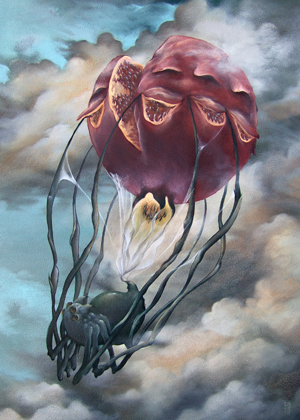
Bernhardt didn’t release his first creator-owned comic book Cardboard City, until 2010, some 15 years after his childhood comic experience. The short-lived action sci-fi publication with a robot as a main character received mixed reviews.
“I made a lot of mistakes,” he says. “I had never done a comic book before. I had trouble drawing certain things, or the pacing wasn’t right. I want to take what’s there and rework it and re-release it.”
Bernhardt loves storytelling and when he’s not painting, teaching or tattooing, he is home storyboarding and figuring out characters.
He started his professional art training in his early 20s, when a friend got him an interview for a graphic design position at a Tower Records production office.
“I started at Tower Records—it was kind of like the evil empire, a bizarre work environment,” he says looking back. “When I started I had no real graphic design experience, I knew a little Photoshop, I was 20 or 21, but I took some of my work and titled the folder ‘Please hire me,’ and the person interviewing said ‘It’s not the best work, but I like your attitude.’”

Bernhardt learned from other graphic artists working at the office and later produced freelance work for local bands and businesses—flyers, stickers, whatever he could try.
Hoping to further hone his skills, Bernhardt studied illustration in 2005 at the Academy of Art in San Francisco. In 2009 his freelancing and illustration work landed him an apprenticeship at Pretty in Ink Tattoo in Roseville.
“I never in a million years thought I would be a tattoo artist,” Bernhardt says. “When I was 19 or 20, I had some friends say I should tattoo but I was intimidated by tattoo artists. I didn’t have that persona, didn’t think I could hang out with them. But through graphic design, I got into it.”
Along the way, Bernhardt found much respect for tattoo art and painting.
“What I like about tattooing is it allows me to crisscross back and forth between the art forms, switch gears and do more sequential work or illustration, then go to painting,” he says. “I can’t say I love one over the other. And I think that’s how art is going today. You have to be able to cross genres, put down the pencil and pick up a camera, then put down the camera and pick up a paintbrush. But it is hard to find a distinct style.”
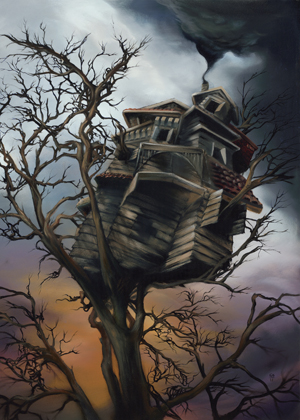
Bernhardt says he found his painting style, which reflects in his other work, when he first started putting oil on wood.
“I was never interested in painting—I just wanted to be a comic book illustrator—but when I started working at a tattoo shop, both tattoo artists I worked with were oil painting and they would bring out a canvas in between clients,” he says.
The practice intrigued him.
“With tattoos you would think it’s more about drawing, but it’s more like the fundamentals of painting, color theory, mixing colors,” he says. “Until I tried it I didn’t realize that. And when you work at a shop, you can put [your painting] behind you and a client will see it and might want it. It’s one more thing in your arsenal when you’re a freelance artist or independent contractor.”
So Bernhardt took a magnifying glass to his favorite artists’ prints and chose oil on wood to begin painting. A Circa Survive album cover inspired him, and he found out the artist had been Esao Andrews. His style, along with that of James Gleeson, left an impression.
“When I saw what those guys are doing I was like, yeah, that’s what I want to do,” he says enthusiastically. “It’s beautiful, grotesque, what I admire and I’m trying to emulate that kind of universe that they paint in. I think what made me so attached to that style of painting is when you see the painting, you want to be there, you want to see what it’s like to live there for a day.”
Bernhardt is more attracted to painting the bizarre in nature, using animals, insects and fruit.
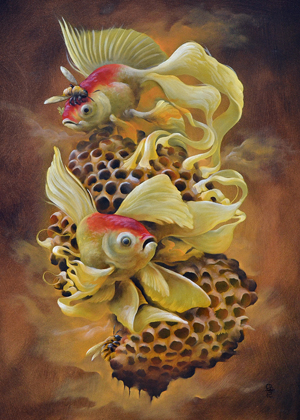
“I like to do bizarre things like put a fish in the sky, a bird under water,” he says. “It’s more a conceptual thing than a message. I’m not trying to convey a message, I’m just trying to get a feeling out of it.”
Bernhardt has only been practicing fine art for a couple years, but he has befriended a slew of Sacramento artists along the way. After connecting with local tattoo artist Jessica Ann White, and sharing with her a vision for a fine art gallery that also includes a tattoo shop, the two decided to open Reclamare Gallery and Custom Tattoo at 2737 Riverside Boulevard in Land Park.
The gallery will host pieces from both Bernhardt and White regularly, as well as from Andy Steele, Jared Tharp, Chris Bales, Jared Konopitski, Jacquelyn Bond, Jayme Goodwin, Andrew Luck, Jason Taylor, Kathryn Mayo and Joel Smith during April’s Second Saturday.
“I wanted to get people to keep coming to the shop and also help other local artists by being a hub,” Bernhardt says. “You see that nowadays, there will be a gallery but there will be a bar or something in it, so the gallery doesn’t draw a lot people but you can get them in for a drink. I wanted people to know this was for fine art. It’s a gallery for artists who happen to do tattoos.”
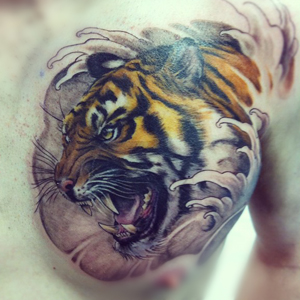
He also wanted a place to host local workshops, classes and artists who could teach painting, as a way to give back to the community that supported him. Currently, Bernhardt teaches figure drawing at University Art on Marconi Avenue.
“I just want for people to be comfortable and talk about art and not be intimidated by that whole culture,” he says of the new gallery.
Bernhardt is happy with the location of the gallery and shop because he doesn’t want to take away from the tattoo studios that have been established downtown, and because the gallery is in line with a few others in the immediate area.
“We’re also across the street from the cemetery, which is kind of creepy but it’s beautiful,” he says, noting he thought the shop might be haunted but took care of any possible spirits before opening.
Just another small scare along his path. No big deal.
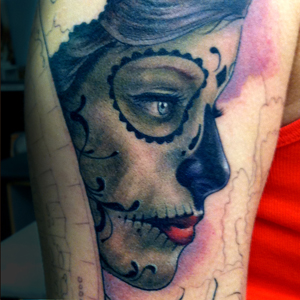
For more info, visit Reclamare’s little corner of Facebook, Facebook.com/Reclamaretattoo.
Justin Wood’s work shows the possibilities of the digital image
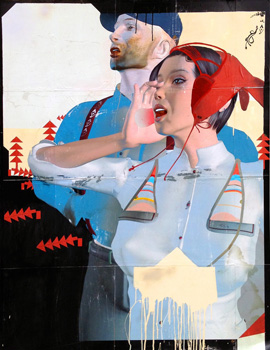
The Vocal, 2003
An olive-skinned woman with a smooth, red cap and jet black hair silently calls out into the distance; her piercing dark eyes are accented with the soft hint of blue balancing the crimson star shaped buttons of her button-up shirt. Just behind her, a man of medium build stands quietly in a comforting manner, a 5 o’clock shadow casting across his solemn face. Behind both these figures, red triangles bond together resembling pine trees and what starts as a lightly colored background of yellow sky blends into a darken abyss of black medium running off the end of the hanging canvas.
This piece of art titled The Vocal, along with dozens of others, is part of artist Justin Wood’s latest body of work, Family Affair, displayed throughout March at Midtown Village Café on 19th and I streets, Sacramento. And although The Vocal does contain some paint, this piece and all his work displayed was ultimately created on a computer at the hand of Wood, then printed and pasted to a canvas for all viewers.
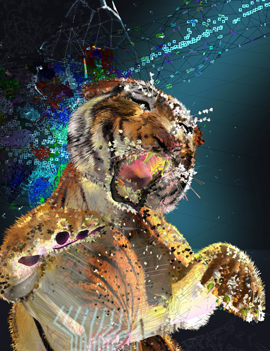
The University of Missouri’s Alumni Magazine, 2012
“What I’m really interested in is juxtaposition and mixing and smashing things together that don’t really work. The synergy between digital and analog is interesting,” describes Wood. “I was struck by the openness of [digital or mixed media] and that you could do so many different variations of everything you wanted to.”
The digitally crafted pieces that line the walls and hallway of the eclectic Midtown café log more than 10 years of Wood’s artistic career ranging from as far back as 2002, to a set of psychedelically colored women hanging toward the front of the business that he says were more recent. Wood credits his digitally contrived dexterity to his parents, his mom being an abstract painter, and his father, a computer software programmer.
“There’s this big mix between mom doing traditional painting and my dad hackin’ on the computer all the time,” explains Wood. “I think that’s kind of how my interests sort of came together or how the aesthetic came together in a way.”
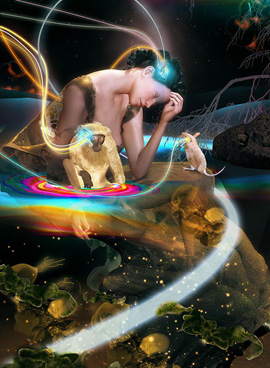
Optogenetics, WIRED Magazine, Oct. 2009
Wood’s father also had a heavy influence in the early development of MIDI music, a computer software capable of not only allowing musical instruments to communicate with each other, but giving one instrument the ability to control another or multiples. Just think, if a piano is programmed to play a G-note, then a trumpet, or clarinet or whatever other instrument available would also follow suit. Technology, people, it’s rad.
But, despite how sharp, intense or intriguing Wood’s images are, the measurement of effort when it comes to digitally crafted work within the art community and between art enthusiasts remains indifferent. On more than one occasion during art shows, Wood found himself facing loaded questions from viewers like, “Where’s the skill?” or “Where’s the craft?” It’s an attitude he’s grown all too familiar with since displaying his work in galleries in San Francisco, Los Angeles and even Germany.
“Just because you work on the computer, it’s not just pressing buttons. It’s not just saying, ‘Do this,’” says Wood of his creative process. “But, everyone couldn’t get over the fact that I was doing art digitally. So, I would try to sell my work in galleries and people would be like, ‘Oh, so you just press the art button?’”
The art button.

Divers, 2012
Wood compares this imaginary art button odium to photography, asking critics if a photographer is just a mere, talentless dreamer armed with a fancy mechanical device and a shutter-happy trigger finger?
“It’s a huge stigma because people don’t understand how you do it. You know it takes a hell of a lot of effort to make a good photograph,” says Wood. “You might get lucky once in a while, but you have to be a really good photographer with a great subject to make a really compelling photograph.”
When Wood isn’t defending his digitally driven creative methods, he’s drafting editorial illustrations for various national and international publications like The New York Times, Money magazine and also reaching overseas with Men’s Health magazine in Germany. He candidly admits choosing art as a career proves difficult financially at times, especially with his budding family to provide for in wife Laura and two-year-old daughter, Ida.
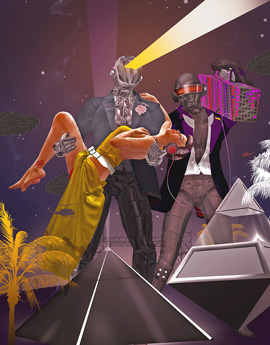
Daft Punks, Las Vegas Weekly, 2007
“I thought if I’m going to be an artist, I’ve got to be able to put bread on the table,” says Wood. “My mom was an artist and we were dirt poor. [She’s] always telling me how sorry she is about where we grew up. But it gives you experiences that you cannot get anywhere else and new ways to look at and appreciate things. It was important for me to be able to figure out how to at least make a little bit of money.”
His wife Laura is an architect who explores art freely in her spare time and coincidentally, has several pieces of her handcrafted art displayed at Midtown Village Café alongside her husband, and she also has an installation inside the California Museum on O Street standing over 10 feet tall. Inside the café, her oblong-shaped mobiles hang from the ceiling or are mounted against walls in various colors reflecting light and embracing the shadows their cardboard angles create.

Justin and Laura Wood
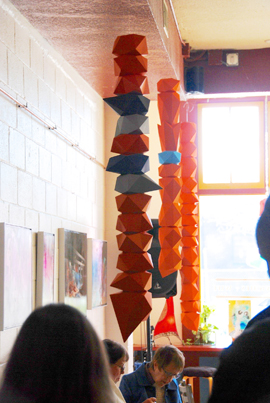
Laura Wood’s hanging mobiles
“We have a similar aesthetic, but it’s totally from different ends of the spectrum,” says Wood. “She’s not into pretty pictures…she’s into figuring out how these forms relate to space and how to manifest them in 3-D. It’s inspiring.”
Still, Wood’s affinity toward the digital realm versus the more analog will never stop him from defending his techniques because while he enjoys creating from a computer screen, he often finishes his work with paint. He explains this push and pull between mediums as a reoccurring conflict while creating art digitally, but often finds himself slightly returning to the physical when he finishes a piece with paint and physically displays it at a small café or gallery.
“I hope that there is this certain struggle that is illustrated in the work, which is where do we fit in this new, digital world,” asks Wood, who then poses these questions for critics of the digital and mixed media art process.
“Do you like the image? Do you find the image compelling? Do you find it interesting? Do you find it controversial? Yes? OK, then, does it matter,” he says.
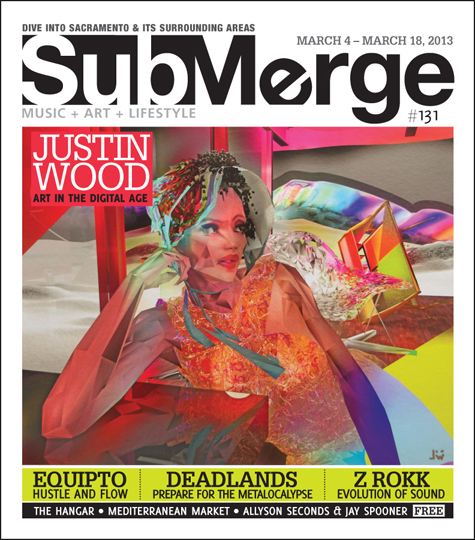
It’s a Family Affair, Justin Wood’s joint show with his wife Laura, is now open for viewing at Midtown Village Café in Sacramento. Midtown Village Café is open seven days a week and is located at 1920 I Street. For more information on Wood, visit his website http://www.singlecell.to/.
Sacramento artist taps into a childhood obsession for his latest show
Pop art in the ‘60s and a growing critique of consumer culture at the end of modernism led art into an aesthetic of mash ups, parodies and pastiche. Pulp art, comic books, baseball cards and the developments of global branding strategies all collided into Wacky Packs, a series of stickers that mocked consumer goods through parody, produced by Topps Trading Company in 1967, and originally illustrated by Art Spiegelman (writer/artist of the graphic novel Maus) and Norman Saunders. Fast forward 45 years, the influence of these seemingly benign stickers can be found in the artwork of Bruce Gossett.
Gossett’s works have been seen at a few select galleries around Sacramento and sold at various car shows over the past decade, but his current work draws specifically on the playfulness and base impulses of a childhood fascination: Wacky Packs. His artwork follows this tradition of plagiarism and parody, using existing advertisements and iconography from the custom car world to create tongue-in-cheek fine art works that connect an adult world of masculine custom hot rods with the juvenile playfulness of puns and gore.
Gossett has developed his art over the years working with multiple graphic forms, all of which have influenced his relationship to the canvas, his preferred medium. He’s printed T-shirts, rock and car show posters, stickers and done customized airbrushing and detailing on cars. He once tried his hand at stand-up comedy, only to realize he didn’t like the spotlight and has since found his calling in a small, insulated shed-studio in the back yard of his West Sacramento home. Gossett spent years going up and down California, attending car shows, selling his works: T-shirts, posters, stickers, fine arts. And the influence of this culture has been foundational to his development as a graphic and fine artist.
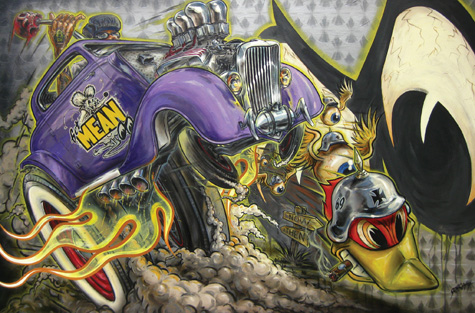
But it’s not just car culture in general that Gossett finds alluring, it’s a specific subspecies of that broader category, those custom car creators, the seedy underbelly of that combination of Detroit automobiles and California counter culture. This DIY renaissance of the automobile, the material object that transported America from farmlands to urban spaces, appears in the work of Gossett as an image set to be appropriated and employed according to a particular set of aesthetics.
These counter culture references are manifest in his current work, the Speed Equipped series, which will be shown for Second Saturday in October at So-Cal Speed Shop on Del Paso Boulevard. The Speed Equipped show focuses specifically on parodies of logos for hot-rodding companies like Moon Speed Equipment, from which the show takes its name. Gossett has created a set of produce brands with the low-brow humor of those Wacky Packs, and he has even been tapped by Anti-Hero Skateboards and local John Cardiel to create the artwork for a pro-series of decks. Gossett’s works span multiple culture groups and as such he’s a significant contributor in the battle against bourgeois ideals and high-art. He’s a working class artist, and that’s just why we like him.

Tell me about your new show, Speed Equipped.
I was obsessed with Wacky Packs in the ‘70s. They were parodies of national products. You know, household products, Windex and stuff like that. They basically mocked them and made fun of them. They were stickers in chewing gum packs. I remember kids covering their closet doors with them, much to the chagrin of their parents. I got obsessed with them. It was funny. The imagery was so base and crude, like it was painted with a broomstick or something. The humor was just great.
Finally, I thought about it one day, and I’ve never seen parodies of the speed equipment. I’ve always been immersed in the car thing, and I thought why not make fun of the icons of the rod and custom world. It’s something I’ve been working on over a two-year period. I’d like to get them out there and get them seen. I think there’s a generation that grew up in the ‘70s around Wacky Packs, skateboarding, punk, irreverence and that audience totally would get it.
I’m also showing some of my Builders Series. It’s the guys that build cars that I dig, but they’re the new generation of builders as opposed to the old generation. It’s not fair cars and Sunday drives, lawn chairs and car shows. There’s a new generation of builders and hot-rodders and the vast majority of them are coming out of the skateboarding world.
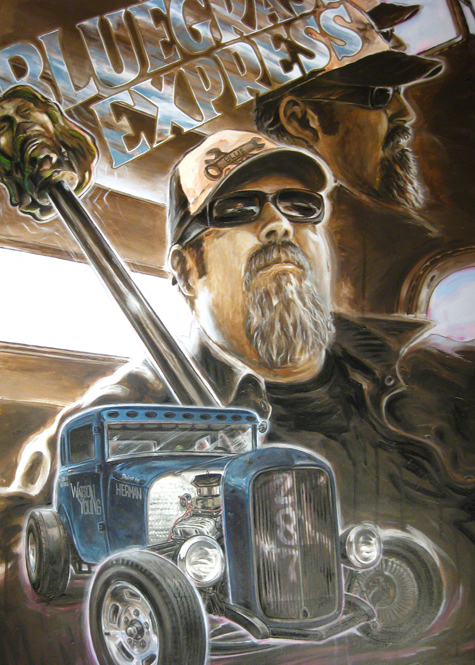
Can you explain how that series is different for you? How it’s a change of direction from your previous work?
The Builders Series is more photo-based. Sometimes it’s the vehicles they build, and I’ll focus on that. Other times I’ll start introducing images of the builder, so it’s a little more personal. It’s difficult, painting portraitures and capturing likenesses. It’s more representational, photo-realistic, but I’m making them psychedelic, lots of drips, lots of maneuvering of the surfaces so that you know it’s a painting as opposed to an airbrushed, photo-realistic work.
What’s the best and worst parts about being an artist?
Being locked in the studio is boring, frankly. There’s nothing more I’d like to do than be in the studio for 10 hours and paint. But by that eighth hour, I’m probably pretty sick of it. The days are weird. There are times when it’s fun; there are times when it’s work. I think I like the beginning and the end best. I like when it hasn’t been touched and I first lay in backgrounds, working from the rear forward. You’re establishing a mood when you first start, so it’s fun. Anything is possible. And in the end, it’s always nice to finish something. You’re happy it’s out of the way.
Once I finish something, I don’t want to look at it for a while. Then a week later I’ll obsess over it for about a week, and then I’m usually pretty good with it. For that reason I always have half a dozen paintings going at any given time.
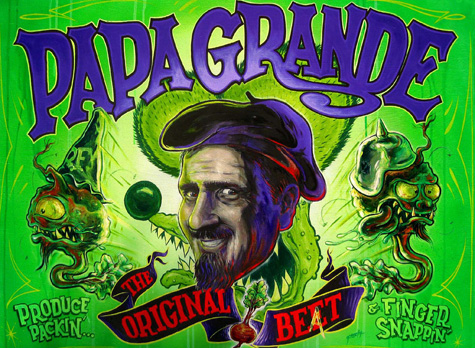
How do other forms, graphic design, T-shirt printing, etc., influence your work?
These are like complex graphics really. My knowledge and experience over the years from different industries, sign painting, pin-striping, graphic applications for hot rods, on vehicles, I get a lot of influence from those other forms. To produce really clean graphics you work rear forward. Do your infill colors and then hit the black lining. It’s really the cleanest way of producing stuff.
When did you decide to take your artwork seriously?
After about the first year, I took it seriously. I started in 1989. I’ve always designed stuff and did things with paint. We stole Testors paints from Thrifty’s and pay for a ten-cent ice-cream cone, and we’d customize our skateboards. I’ve always been around cars, my family was in the car industry. I wanted to get away from it, so I actually tried my hand at stand-up comedy. That didn’t go real well. Then I took a class at City College, the material was stale but I took to it real easy. I realized not only that I had an aptitude for it, but that I enjoyed it. And I was useless in other areas. I just had a short attention span, and the art thing seemed limitless. It really took off in the mid 90s when I really started pursuing more of a car based or an automotive bend.
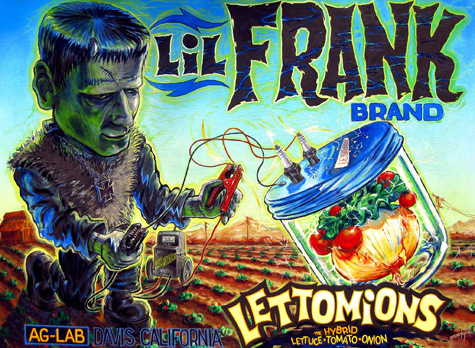
What is it about cars and hot rod culture that you find so alluring?
I’ve always had old cars. My first car was a 1972 Chevelle I fixed up before I had my license. It seemed like a meathead world to me. You’ve got to understand the ‘80s. It was the dark days for this car thing. There was a renaissance in the ‘90s, and I got introduced to Big Daddy Roth and that whole world. It was like the thinking man’s hot rod. It was the Bad News Bears, and I missed that from when I was a kid. I realized there were these weirdo hot-rodders, and it totally clicked with me. I decided to get back into it. I built a few cars. I just jumped in.
Even if it doesn’t have cars, I still call some stuff hot rod art. It’s just got an aesthetic. Even a portrait or something, just the way the paint’s moved, it screams hot rod to me. I like a lot of aggression in my art, a lot of action and movement.
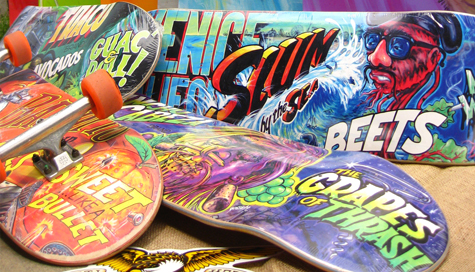
How’d you get hooked up with Anti-Hero Skateboards and John Cardiel?
Cardiel saw my Fresh Ripe and Delicious show at A Bitchin Space. He saw the preview in the University Art window, and he totally got it. He totally remembered the Wacky Packs. He said, “I’ve got six riders and I want you to personalize a piece for each one.” I got where each rider was from, their hometown, where they were born. I did a bit of research and developed ideas. It was crude, tounge-in-cheek, vulgar, but it was a skateboard company, no holds barred, and he totally got it. He’s a squirrel; he’s cooler than shit. It was the most perfect client you could ever ask for.

Bruce Gossett’s Speed Equipped opens at So-Cal Speed Shop in Sacramento on Oct. 6, 2012 from 4—9 p.m. The Second Saturday reception will take place the following week, Oct. 13, 2012 from 5—10 p.m. While there, check out a preview of Gossett’s Builders Series. For more info, contact Gossett via http://www.facebook.com/BruceGossettStudios.
From clutter, artist James Mullen assembles pieces of grotesque beauty
If you are looking for art that is pretty, don’t expect it from James Mullen. This artist is not out to make art for beauty’s sake.
What is more important to him is to turn heads, in the same fashion that heads turn when people hear the sound of a car wreck, whether they want to see the carnage or not.
If he has caused the observer to ask questions like, “What was he thinking?” or, “What the heck was he up to here?” then consider the piece a success.
“To have a piece that is a bit dark and disturbing is to be that car wreck,” the Sacramento native says. “I’m not looking to hold up an object for admiration; rather, I’m looking to grab someone’s attention, grab them by the lapels and prevent them from looking away, almost to rivet them in place.”
It is appropriate that he should mention rivets, considering his upcoming exhibition, Jagged Edges, at Bows and Arrows, a collection of three-dimensional nail fetish pieces that incorporate wood, nails and doll parts. This body of work, inspired by Congolese nail fetish pieces displayed in the de Young museum in San Francisco, will hopefully make people’s hair stand up, Mullen says, as it is one of his “darker” collections.
A personal favorite is Nail Fetish #8, which is almost Christmas tree-like in a grotesque way. The flayed skin of a doll is wrapped around a triangular piece of wood, a thick spiral of nails curling around it. A telephone rests on the doll’s arm, and in its opposite hand it holds a compass. The piece is whimsical and heavily influenced by Dadaism, Mullen says.
“I find it very powerful and a little disturbing, perhaps, which is what I’m going for,” he adds.
To be clear, Mullen is an abstract assemblage artist. His artistic process is very organic, he explains, in the sense that the objects he starts with will dictate his final product. He may grab one piece from the rafters in his studio, and the rest of the work comes together around it.
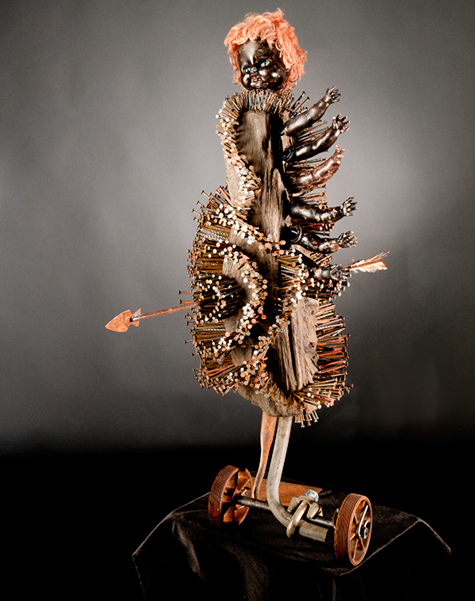
Nail Fetish #4
“I don’t know where [the piece] is going or where it’s going to end up, but I just start,” he says. “Starting [gets] the creative juices flowing, and the ideas start moving through my head, and the piece will grow from whatever object just comes to hand.”
As far as what comes to hand, it is an eclectic mix of items that form Mullen’s artistic palette. In this way he is also a collector of odd and interesting things. Animal skulls, for instance, pieces of wood, a rusted bike frame or a horse’s jaw are considered treasures. A goat skull he found on the side of the road was integrated into one of his nail fetish pieces. Often these are objects he finds on the Walker River alongside U.S. Route 395 near his home in Grass Valley, or on bike rides, at garage sales or junk stores.
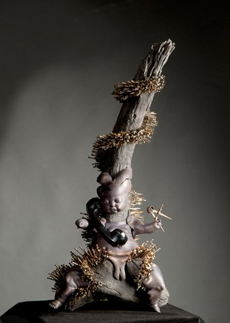
Nail Fetish #8
Unable to see Mullen’s studio with the naked eye, Submerge asked Mullen to describe his studio in Grass Valley. He did; he also sent pictures of it.
Work surfaces and shelves disappear beneath seas of hand tools, saws, canisters, tubs and boxes. Odds and ends are piled high, while a web of doll heads, cables, tubing and a picture frame hang from the ceiling. This is where he has spent 20 to 30 hours per week creating his nail fetish pieces. From this clutter emerges Mullen’s works of art.
Each work comes together using epoxy, nails, rivets, screws, wire and pressure. The natural tarnishes of the pieces he uses are integral to the characteristic of his work, he explains. In order to preserve the rust and grit of his assemblages, he chooses not to weld, though he knows the skill.

Nail Fetish #2
“I really enjoy the patina of age that items show during a lifetime of wear and weathering and what have you, so I don’t weld,” he says. “I do wear out a lot of drills.”
Assemblage was not always Mullen’s forte. Once upon a time, he worked with clay. In fact he has worked with it on and off for 40 years, since he first began sculpting in high school.
Like a writer becomes afflicted with writer’s block, or an artist walks away from a painting, he too experienced a dry moment sometime in 2007, when he no longer wanted to work with clay. He stopped midway through a sculpture, and for four months did nothing more with it or any other clay works.
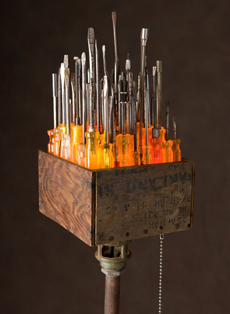
Screwdriver Nitelite
Still, he knew he wanted to create art. So, while standing in his backyard, his eyes fell upon piles of rusty fencing, wood and sheet metal, and he decided that these pieces would become his new media. He has been an assemblage artist ever since.
Whoever takes a Mullen piece home has little control over how to display it, because Mullen already has that taken care of. Often he intentionally builds a base into his pieces so he has leverage over the angle it is seen, whether they are built onto pedestals or elevated with wooden chair or table legs. This creates a towering effect.
“Once you make a piece and send it off into the world, you don’t have control anymore on how it’s going to be treated…what people are going to think of it. It’s all out of your hands,” he explains. “But by building the entire piece and including the base, I at least have some influence over the perspective of which it’s viewed.”
Practicality doesn’t always come into play in his pieces, however. As he is largely influenced by the Dada school of thought, his pieces are meant to be illogical and nonsensical.
“I don’t overintellectualize art. I try not to dissect it,” he says.
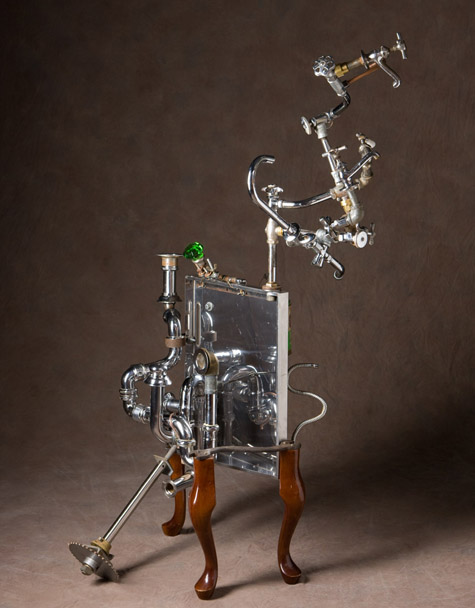
The Plumbers Daughter
Take one of his older pieces, Plumber’s Daughter, for instance. Plumbing pieces, a section of a steel grill, a doorknob and a lard bucket are arranged vertically atop cherry wooden table legs. There is no rhyme or reason to the bathtub-like creature, except that it was dedicated to Mullen’s wife, who is, in fact, a plumber’s daughter.
While it is a head turner, there is little other meaning behind it. In the same vein as Rube Goldberg, these are little steps to absolutely nothing, he says.
Bows and Arrows will host an opening reception for Jagged Edges on Friday, June 1, 2012 from 6—9 p.m. Find out more at http://bowscollective.com/. You can delve deeper into the mind and art of James Mullen at his website, http://jamesmullenartist.info/.
For Jon Mess, Music and Art Share a Similar Rhythm
Artist Jon Mess might be the only human example of going from zero to 60 and back in 3.5 seconds. One second he is thrashing paint on a canvas with quick and forceful strokes; the next he is stopping and staring intently at the chaos before him. He likes to start off a painting at a very fast pace but then slows down to analyze each stroke. At times he will stare at his work for more than 30 minutes.
For the past 10 years, Mess has experimented with various art forms including painting, graphic design, writing song lyrics even perfecting screamed vocals. His causal demeanor and laid-back personality make it seem surprising that his well-known talent is screaming lyrics in front of raving fans. He has been in the spotlight as a vocalist for Sacramento’s post-hardcore band, Dance Gavin Dance, but has been under the radar as a talented local artist. Each creative side of him represents the perfection of organized chaos; that can be heard in the vocals and seen in his art.
“I try and create a sort of rhythm with the strokes…like the way that music or notes would go up and down on a scale,” Mess said while sitting on a bench outside of his art studio. “I like the element of just going at it and moving real fast but at the same time I want to have balance and stability and take into account [the] formal element of art.”
His abstract artwork is full of bright colors and sharp strokes that leave no empty space on the canvas. Each piece of art is completely open to interpretation and everyone will have a different opinion on what the image is or what it means to them. It’s a “choose your own adventure” art show, Mess said. One minute you might see a rabid zombie dog but after a close examination you might see two eerie dark figures appear in the painting.

Horse, Oil on canvas 30’’ x 40’’ 2012
To get started on a painting, Mess lets his natural intuition and spontaneous side work together. “That’s one of the main things about my process is that I don’t work from an image or I don’t usually work from an idea,” Mess explained. “I put a mark on the canvas, then another one and then it starts to look like something.”
But if Mess does have a sporadic thought in his head it normally comes out as a painting, a lyric or sometimes both. From the most recent Dance Gavin Dance album, a song titled “The Robot with Human Hair Part 2 ½” contains three words that seemed to cause a small uproar with some of his fans.
“There is this one lyric that is ‘confusing ice cream cone.’ People were always misinterpreting or are confused as why the lyrics weren’t cohesive, just scatterbrained. Well, my lyrics are confusing ice cream cones,” he said. “Then I painted a big ice cream cone with a big question mark.
If it works, it fits in the song and fits on the canvas, why do I need more meaning than that? Why can’t I just paint anything?”
Having a creative process isn’t new in his family; in fact his artistic talent could prove that the creative gene might be a dominant one. Growing up he watched his mom sculpt clay vessels and “curvy vases”; he worked for his uncle, a veteran artist who builds massive metal creations; he is related to one of the animators of the legendary cartoon show The Simpsons; and his cousin works for the art department at UCLA.
“Why is everyone an artist? This must be genetic,” Mess said about his artistic family history. “My mom always had a studio attached to the house with kilns, a potter’s wheel, clay and paints. I learned and did sculptor clay when I was a lot younger and I starting painting when I was 16.”
Since then, he has completed many paintings that he is ready to share with the Sacramento community. Starting on April 14 the FE Gallery will display some of his work for his fans and art enthusiasts to enjoy. He is excited to move all of his artwork from his current studio (that he shares with other local artists in downtown Sacramento) and formally hang it in an official art gallery.
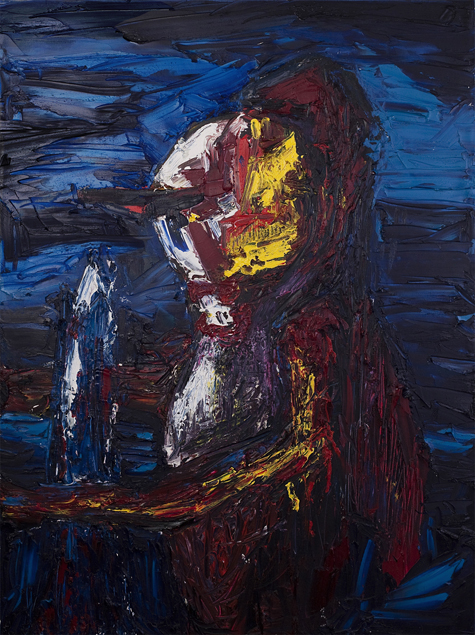
CominUp, Oil on canvas 30’’ x 40’’ 2011
The final product of the art show will have a completely different vibe than Mess’ current workspace. At first glance his art studio resembles an abandoned warehouse, but after walking inside and smelling the paint fumes, anyone could sense the hard work that surrounds the studio. The crowded building is divided into multiple messy workstations, and it’s hard to tell where one art station begins and where the other one ends.
But this environment is a recent upgrade from working at home in his apartment. “I was getting paint on the carpet, the walls, my hands, bathroom and my cat. [It] would get on him and he would track it around,” Mess said. “So out of necessity I had to move it all out. It’s been really nice.”
His upcoming show will be his first official gallery show, apart from college galleries at Sacramento State. While attending college, Mess studied electronic art and started to feel out his interest in post hardcore metal music. This slight interest and curiosity led him to become a famous hardcore screamer, a skill that he happened to pick up randomly.
“I didn’t know what I was doing at all at first and there was no real guidebook,” he said. “I asked a vocal coach at Sac State and they were like, ‘You are going to destroy your voice. You can’t do this. You’ll have no career.’”
If Mess had believed the unfaithful coach, he wouldn’t have toured with Dance Gavin Dance across the United States, and he wouldn’t have been called a “resident screamer” by Alternative Press. After being told he would have no career in screaming, Mess ended up headlining Sacramento State with his band almost right after his graduation date. But in terms of his future career, Mess is a little unsure of where his art will take him. He is going to “play it by ear” but doesn’t plan on slowing down anytime soon.
“I’m trying to stay within the creative field but in terms of what specific path it’s going to take,” Mess said. “I know that I can always just paint forever.”
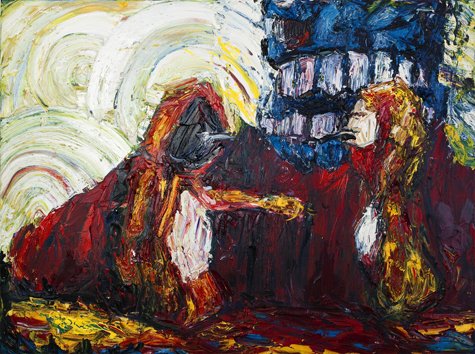
Washing, Oil on canvas 30’’ x 40’’ 2011
Check out the works of Jon Mess at FE Gallery. The exhibition will run through May 3, 2012. The gallery is located at 1100 65th Street, Sacramento and can be found online at http://www.fegallery.com/. If you’d like to see more of Mess’ artwork, go to http://jondmess.tumblr.com/.
Local Artist Jim Shepherd, Jr. puts his love of Sacramento locales on canvas
To a degree, relationships are a matter of how much time you can stand to spend with someone. With family, friends, acquaintances… Or paintings.
Sometimes, Jim Shepherd, Jr. finds his relationships consuming enormous chunks of his time, to the extent that his only moments away from it are to eat or use the bathroom.
One of these recent relationships was with a 4-by-6-foot painting of a scene inside Old Ironsides. He built the stretcher bars himself. The painting was done with oils rather than acrylics, a more arduous task.
“There was a day when I spent 15 hours just working on that monstrosity,” he recalls.
It was not unlike a relationship with a person, he adds, where it becomes a test of how much time you choose to spend around someone.
When he found it hard to break away from the painting, he knew his heart was in it.
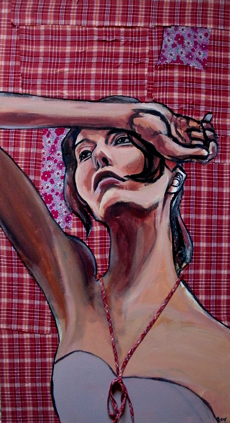
“That’s awesome to me, when your heart is so connected to something you can’t part with it,” he says.
Shepherd is a local artist. Some of his more recent pieces will be in two different shows around town this month; one of which will have kicked off at Slice of Broadway this past Saturday by the time this issue is released. The other show will open on Nov. 18, 2011 at the Vox at Thinkhouse for their one-year anniversary.
For a while, Shepherd’s paintings focused on women. He would conceptualize the women and settings to paint them in. “I think it’s my hormones maybe, or just practicing [painting] the body, I guess. Who knows?”
He has integrated fabrics into some pieces, scavenging clothing in thrift stores and then cutting them up to glue onto canvases and paint over. A plaid fabric becomes the backdrop to a painted woman, for instance, and a piece of string rests around her neck.
After painting so many women, he is finally reaching a burnout point, he admits.
Nowadays he finds himself painting places he frequents. He will bike around town and snap photos of the places he then paints: Townhouse, Old Ironsides, B Street Theatre or Tower Theatre.
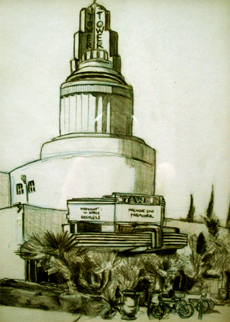
These are not concepts randomly pulled from the ether, he assures. This is a way he expresses love. Similar to his paintings, he has established a sort of relationship with these places, he says. Each location bears some kind of significance in his life.
This is how Old Ironsides, a place that has become a regular hangout for Shepherd, became subject matter for a painting.
Now he is working on painting the eerie two-story house at the corner of H and 21st, just down the street from Old Soul at Weatherstone. The fine details, the shingles of the house and whatnot, has made it another time-consuming piece.
Another common theme in his paintings is images accompanied by words, either lyrics from songs or quotes from books.
He pulls out a framed canvas from his backpack. The bottom layer is black floral fabric pasted down. Over it he painted bottles of alcohol and the words, “No, free spirits ain’t setting no one’s spirit free,” a quote from the song “Woo! Alright, Yeah… Uh Huh” by The Rapture.
“I’ve always liked the idea,” he says. “Even though you’re drinking doesn’t mean you are having a good time.”
This recently completed piece will be on display at Slice of Broadway.
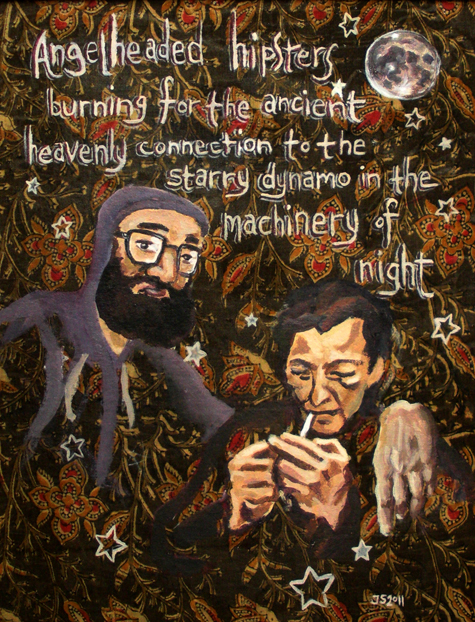
Sometimes his intrigue with his surroundings is overwhelming, he says, to the point that he has trouble focusing on ideas.
Now he is exploring the idea of moving beyond painting pictures to “maybe start seeing the world around me in a sense and commenting on it, being a little bit more reflective.”
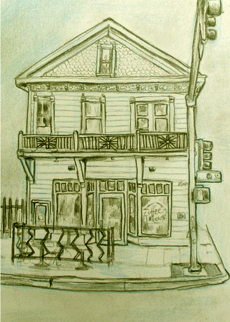
Another project he has begun to plan involves creating art that the blind can experience.
“Someone that paints like this, a blind person wouldn’t know what the hell this is,” he says, tapping on his painting.
The idea was born from the question: “How do blind people dream?” How do they see people or color in their dreams, he wondered. After pitching the question to a blind person, it evolved into another question: “How do blind people experience art?”
When it comes to visual art, “there’s this whole world that I can experience that they can’t,” Shepherd explains.
The project is still in the conceptualizing phase, but the pieces will be primarily based on touch, using different textures. Shepherd is looking for an ADA-compliant location to feature the exhibit and people to spearhead the project with him.
What is truly rewarding, he says, is the ability to emotionally move people with his art. Ideally, he would like to move strangers enough that they will want to buy his work.
Like many struggling artists, though painting is his passion, it is not his primary source of income.
“That would be fantastic if it was,” he says. He graduated from Sacramento State last year with a degree in art studio. Ideally he would like to continue school, possibly enter a master’s program. He could use the discipline, he says.
Money is an issue, though. Compared to other artists, Shepherd asks very little for his work, he says, making it difficult to sustain an income this way.
For now he works 40 hours a week, making enough to pay for his small apartment in Midtown.
It’s not the most ideal setup for an artist, and he finds himself often working with “shitty lighting.” Despite limited resources, though, he plans to create, come hell or high water.
“I think people need to kind of struggle a little bit to appreciate the good things,” he says. “And if good things happen to me, well, then I’ll damn well appreciate them.”
See Jim Shepherd, Jr.’s work now at Slice of Broadway, located at 2424 16th Street in Sacramento. More of his work will be on display later in the month starting Nov. 18, 2011 at Vox at Thinkhouse, located at 1818 R Street, also in Sacramento.
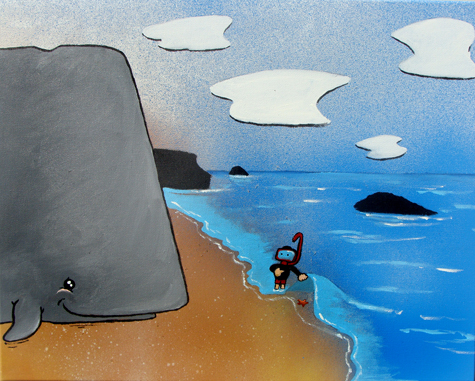
Jared Konopitski is one of our favorite Sacramento artists/illustrators and his upcoming solo show at Side Show Studios (5635 Freeport Boulevard, Suite 6) is easily one of our most highly anticipated of the summer. In this particular show, which celebrated its opening on Sept. 10, Konopitski has 30 new paintings on display. According to his website, Jaredkonopitski.com, “If you like candy, cartoons and think nightmares are hilarious then this is the show for you! Paint scribbles made into the form of awesome! Perfect for hungry retinas!” Submerge was lucky enough to see a few of Konopitski’s new pieces from the upcoming show just before we went to press with issue no. 93, including Nature Show, in which an owl and a robot share a tree limb on a starry night, and Home Sweet Home (pictured above), a cartoon-ish beach scene showing a cute li’l scuba diver peeling back the ocean just a tiny bit for a massive beached whale to somehow fit through. You get the idea? Konopitski’s art is fun stuff to look at. Perfect for hungry retinas, indeed. Konopitski’s art will stay up at Side Show until Oct. 4 in case you didn’t make the opening reception. For more information and to view some of his past works, visit his website.
-J. Carabba
Nathan Cordero carves a path from gallery janitor to full-fledged artist
Nine years ago, Nathan Cordero used to walk through the Crocker Art Museum every day. But unlike the other gallery visitors who would slowly roam the hallways and take their turn to enjoy each piece of art, Cordero “wasn’t inspired by any of it.” He would walk into the museum, clock in as the custodian, clean the building and head home without feeling the slightest inspiration from the artwork. “After a while you get sick of seeing the same thing. I always noticed flaws in the art and saw something that I didn’t like about it,” said Cordero over the phone. “After seeing everything for so long you usually find one little thing, sometimes the whole piece that’s just…wrong.” But these days Nathan is taking on a new role of being the artist behind the gallery. Until Aug. 20, 2011, art lovers can take a quick peek into Cordero’s mind by visiting the Nelson Gallery at U.C. Davis.
The 36-year-old Sacramento native has found a way to take everyday objects and turn them into unique handmade carvings on pieces of wood and leaves. The art pieces show images of objects, people and quotes.
Although the common objects shown in the carvings (such as flowers, razor blades, fishing hooks, safety pins and pencils) have no particular meaning, they all share one thing in common. “All of those are really easy to carve on a particular surface of wood. So I was able to do more detailed things on that carving,” Cordero said. “When you are able to cut details, it’s really cool to take small images or small subjects and pile them together.”
One of the “small subjects” that he chose to carve repetitively were cigarettes and pictures of Marlboro cartons. “There’s no political message at all. It has nothing to do with tobacco prohibition. It has nothing to do with promoting cigarette smoking. It’s both controversial and satisfying,” Cordero added. “I enjoy smoking cigarettes. I’ve quit many times, then restarted, quit and restarted. It’s just something that is part of my life, a part of growing up and growing old.”
Cordero also chose to make repeated creations of masked men and women, which were inspired after he discovered a box of photos.
“I found a box of head shots from a theater production in Sacramento; they are all people from the Sacramento Valley. I don’t know any of them,” said Cordero. “My original idea was to conceal their identities and then put them up all over Sacramento.”
Nearly all of the wood pieces that are hanging in the gallery were found “everywhere” outside, many of them coming from construction sites. “I find a piece and know exactly what I’m going to do with it right away,” Cordero said. “And once it’s prepared, it’s ready to go.”
At first glance some of the carvings seem as if they are filled with random letters that are aligned with no spaces in between, but after taking the time to read them, quotes and phrases begin to form. He lifts these quotes from headlines in fashion magazines, such as Vogue or Elle, including “Eighty-Seven Swim Suits to Flatter Every Figure,” “Imagine Christina Aguilera Coming Over to Your Place Every Night,” or “Treat Your Body Like Your Face.” The name of his exhibit, Are You Destined to Become Your Mother?, was chosen from a headline he read on the cover of Real Simple Magazine. But the same headline was also found on a cover of Vogue from the late 1960s. “I thought that was kind of interesting, that decades later the same headline would pop up in a completely different manner,” Cordero said.
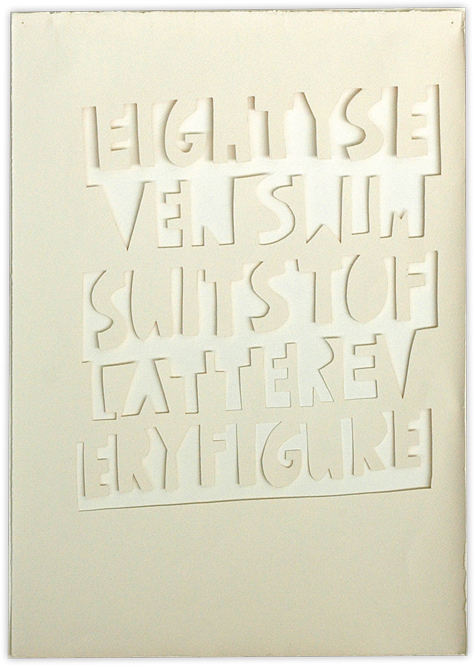
The majority of the pieces held in the gallery were created this year during the span of only six months, which is very little time considering some pieces took Nathan more than 20 hours to complete. During those months of hand carving every piece with razor blades, Nathan would experience minor accidental cuts on his hands about three times a day. All 1,600 razor blades that were used and collected during the hard work almost fill up an entire wall in the gallery. The blades are formed in an X and aligned to create a dramatic 3-D image.
“It’s a tool that I use to do most of my work. I originally just started collecting them,” Cordero explained. “After noticing the amount of shadows from the different directions of light, I thought a whole wall of those would be great. I finally had the chance to do it.”
Although Cordero did not attend art school, he has an eye for recognizing everyday objects people normally pass up and transforming them into a unique art piece. His wood carvings started after he took notice of a piece of wood in his room and “put a hole through it and peeled away at it.”
“I’ve always been interested in art. In my early 20s I actually started to consider art as a career,” said Cordero.
The Nelson is not the only gallery that he has on his resume. His art has been shown at the Verge Gallery and Axis Gallery in Sacramento, The Warehouse Gallery in Syracuse, N.Y., and Ritual Roasters Gallery in San Francisco. Cordero was born in Woodland, “does a lot of fishing” during his spare time and paints houses during the day. But even after his job during the day is over, his art isn’t finished yet. “Whatever time I have available, I’ll work,” Cordero said. “Like today after work, I’ll probably go to my studio and finish up what I’ve been working on.”
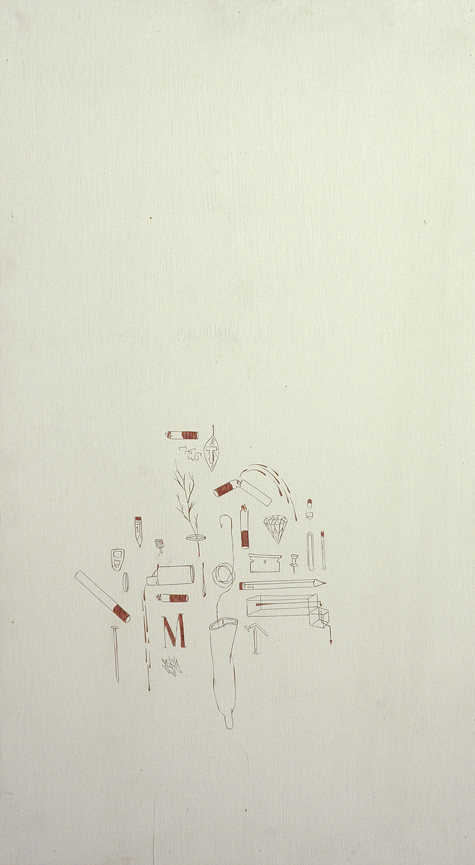
Nathan Cordero’s Are You Destined to Become Your Mother is open now through Aug. 20, 2011 at the Nelson Gallery on the campus of U.C. Davis. The gallery will host a special discussion about the exhibit on Aug. 12, 2011 from 5—8 p.m. For more information, check out Nelsongallery.ucdavis.edu.

j27 Art Gallery
If you’ve driven through or walked down J Street past the 2700 block lately, you’ve more than likely noticed the new sign outside what used to be Papi’s Pizza that simply says, “Art.” Meet j27 Art Gallery, a brand new gathering space co-owned by area artists Susan Rabinovitz and Michael Shane. Rabinovitz, known for her hand-forged jewelry, met Shane, an abstract painter who also owns a shipping and delivery company, at the Sacramento Art Complex where they both had studios about a year-and-a-half ago. “We’d always discussed doing something together,” Shane said during a recent conversation with Submerge. “So about two months ago when I started looking at commercial space I called her up and said, ‘Are you still in?’ and she said, ‘Yeah!’ so we came over and looked at this space. We signed the lease two days later.” Shane pointed out that they are aiming to break the “Second Saturday only” mold and that they want to be “an everyday gallery.” Every weekend there will be something going on, not just on Second Saturdays, be it a live art exhibition, live local music, meet and great sessions with artists and more. Currently represented at j27 are paintings and jewelry from Shane and Rabinovitz as well as a slew of other regional artists’ work including abstract paintings by Gayle Rappaport-Weiland (June’s featured artist); photography from Monica Lunardi and Allister Oliver; fused glass art by Nicole Krohn; sculpture work by Molly Brown, Paula Swayne and Angela Ridgway; paintings from Donna Marie Sterpe as well as cartoonist Eric Decetis’ world-renowned work and much more. Shane pointed out that j27 is proud to be the only gallery selling Decetis’ original art, whose cartoons have graced the pages of countless publications. All in all, j27 has an excellent mix of art found in all sorts of mediums. It’s easy to get sidetracked when in the space, as there are so many eye-catching things to look at. “We’re trying to be very picky about the art that we hang,” Shane said. “We want to have an upscale environment and we want to be the place where people come to buy fine art. But, we want it to be a fun place too; we don’t want it to be stuffy. If you come in, you’re going to hear music, we’ll talk to you about the art, it won’t be dead cold and quiet. It’s important to carry that real high-end stuff, but you don’t have to make it, you know, cold and museum-like.” Learn more about j27 and the artists behind it at j27gallery.com or just stop in. They’ll be open every day starting at 11 a.m. (1 p.m. on Sundays).
-J. Carabba

